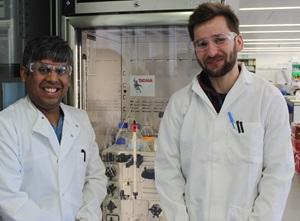Research blast on... Pseudomonas
Q. How is Pseudomonas like the space station in 'Star Wars'?
A. They both have their own protective shields.
One way that Pseudomonas adjusts to life in the lungs of people with CF is by building a protective ‘biofilm’ around itself; a physical shield between Pseudomonas and both antibiotics and the body’s natural defense system. Dr Tanmay Bharat and colleagues at the University of Oxford are studying how this barrier forms. This project is co-funded with Action Medical Research.
Rather than the bacteria themselves forming this physical barrier, they build a protective shield of slime around themselves, a bit like the protective shield around the enemy space station in 'Star Wars'. The shield is built from materials produced by Pseudomonas and existing building blocks already available in the body. Researchers don’t currently know how this shield is put together from these materials – if they can work this out then it will give them clues about how to remove it!

Dr Bharat is studying how the shape, size and chemical make-up of a particular component of the biofilm changes during the building of the shield. If we can understand the properties of the components which make up the shield, then we can design new antibiotics to exploit their weak spots, get through the shield and reach the Pseudomonas.
We spoke to Dr Abul Tarafder in Dr Bharat’s lab about comparing their research to battle scenes in the 'Star Wars' films, and he said: “Most of us in the lab are Star Wars fans so this comparison was particularly apt for us. We have even named some of our equipment after Star Wars characters!"
Abul sent us this photo with colleague Andriko von Kügelgen in front of their machine for purifying proteins, named after the character 'Boba Fett'. May the Force be with Dr Bharat and his colleagues!
Q. Why is a new method for analysing Pseudomonas like a Cyndi Lauper lyric?
A. It’s helping to reveal Pseudomonas’ ‘True Colours’.
The way that Pseudomonas grows in the lungs of people with CF is different from person to person. This means that between different people, Pseudomonas will cause different degrees of lung damage and react differently to antibiotics. Predicting these differences can help provide the most effective treatment possible.
One of the things that causes the differences in different strains of Pseudomonas is the variation in the biproducts it produces. To paraphrase the ‘80s pop star Cyndi Lauper, each Pseudomonas strain has its own true colours. The job of our researchers working in this area is to reveal the true colours of Pseudomonas.
Until now, learning about these biproducts took a lot of sample preparation in the lab. Pseudomonas Strategic Research Centre researchers were the first to discover a rapid new method for detecting these biproducts in samples from people with cystic fibrosis. The method, called ‘REIMS’, zaps a tiny burst of electricity through the bacteria, which ‘burns’ them and creates a vapour that can be sucked up into a machine for analysis. This machine then detects subtle differences in the biproducts produced.
Our researchers are now using this data to understand more about how different strains of Pseudomonas function, and the best way to attack them.
Q. Why is defeating Pseudomonas like defeating an army?
A. The sooner you launch an attack, the better.
After people with CF become infected with Pseudomonas, the bug changes itself genetically to adapt to its environment. These changes better equip the bug to grow and survive.
Pseudomonas may initially infect the nose and upper airways before moving down to infect the lungs. Co-funded by the Trust and Action Medical Research, Dr Jo Fothergill and colleagues at the University of Liverpool are investigating if the genetic changes happen while the bacteria is still in the nose (upper airways), before it reaches the lungs. In their experiments, the team has identified a specific change in the genetic code of Pseudomonas that increases its ability to survive in the body. This crucial change enables the bug to adapt to stay in the body for a long time.
This research could help doctors target the infection much earlier, before it has had a chance to adapt and take hold in the lungs. Just as it’s easier to defend a castle from an invading army at the gates, rather than when they are already inside, if Pseudomonas can be treated before it has managed to spread to the lungs, it could be easier to get rid of.
Find out more about research we're funding to understand and treat CF lung infections or donate today to help support ground-breaking research like this.
